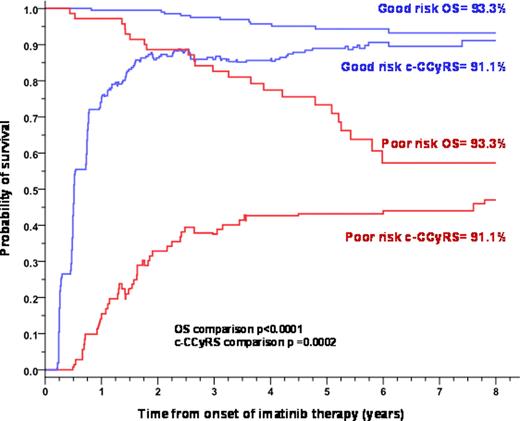Abstract
Abstract 1680
We studied BCR-ABL1 transcript levels in patients with CML in chronic phase at 3, 6 and 12 months after starting imatinib to identify molecular milestones that would predict for overall survival and other outcomes more reliably than serial marrow cytogenetics. We analyzed 282 patients with CML-CP who received imatinib 400 mg/day as first line therapy followed by dasatinib or nilotinib if they failed imatinib.
The median age was 46.3 years (range 13–86.4), 157 (55.7%) patients were male. The Sokal risk distribution was: 31.8% low, 40.1% intermediate and 28.1% high. The median follow-up was 69 months (range 17–131). BCR-ABL1 transcripts were analyzed in the peripheral blood at 12 week intervals using RQ-PCR. Results were expressed as percentage ratios relative to an ABL internal control and converted to the international scale. Complete molecular response (CMR) was defined as two consecutive samples with no detectable transcripts with the ABL1 control >40,000 copies (the median ABL control in the CMR samples was 84,000).
We employed a ROC curve to identify the cut-offs in transcript levels at 3, 6 and 12 months that would best predict patient outcome. Patients with transcript levels >9.84% (n=68) at 3 months had significantly lower 8-year probabilities of overall survival (OS) (56.9% vs 93.3%, p<0.0001), progression-free survival, cumulative incidence of CCyR and CMR than those with higher transcript levels. Similarly transcript levels >1.67% (n=87) at 6 months and >0.53% (n=93) at 12 months identified poor risk patients. However transcript levels at 3 months were the most strongly predictive for the various outcomes. When we compared OS for the groups defined molecularly at 6 and 12 months with use of the usual cytogenetic milestones, categorization by transcript numbers was the only independent predictor for OS (RR= 0.207, p<0.0001 and RR=0.158, p<0.0001). We validated our results by classifying 95 patients treated with imatinib first line at the Royal Liverpool University Hospital according to their transcript levels at 3, 6 and 12 months after converting their local their RQ-PCR results to the international scale. At each time point the high risk patients had significantly poorer OS, namely 69.1% vs 98.3% (p=0.003); 98.1% vs 71.2% (p=0.009) and 98.0% vs 74.4 (p= 0.016) than the good risk patients.
The various transcript cut-offs could be refined in order to better identify those patients more likely to achieve CMR. The 57 patients who had a 3-month transcript ratio ≤0.61% had a 8-year CI of CMR of 84.7%, while the 222 patients with a ratio >0.61% had a CI of CMR of only 1.5% (p<0.0001). Similar thresholds with high predictive power could be identified for 6 and 12 months. We also tried to identify levels of transcripts at 6 and 12 months above which patients in CCyR were destined to fare worse than those with lower values. At 6 months and 12 months, 23 of the 109 and 20 of the 166 patients who were in CCyR had a transcript level higher than 0.53% (the value that we had previously identified as defining the 12 months high risk group); these patients had significantly worse OS (65.8% vs 95.9%, p=0.0002 and 81.5% vs 94.9%, p=0.01) than the 104 and 140 patients with lower transcript levels.
During follow-up 118 patients failed imatinib and required alternative therapy. In order to explore further the impact of early measurements of transcript levels on outcome irrespective of the use of subsequent rescue treatment, we calculated the ‘current CCyR survival’ (c-CCyRS, i.e. the probability of being alive and in CCyR at a given time point). The 8-year c-CCyRS for the whole population was 76.6%. High risk patients had a significantly worse 8-year probability of c-CCyRS than good risk patients, namely 47.0% vs 91.1% at 3 months (p=0.0002) and 53.1% vs 91.3% (p=0.0001) at 6 months (Figure 1). These findings indicate that the prognostic value of early measurement of the residual leukemia burden retains its value even for patients requiring treatment with second generation tyrosine kinase inhibitors.
No relevant conflicts of interest to declare.
Author notes
Asterisk with author names denotes non-ASH members.


This feature is available to Subscribers Only
Sign In or Create an Account Close Modal